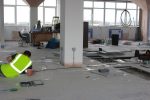Like other trade-related jobs, electricians perform some of the most dangerous tasks in the global marketplace.
These dangers are often related to meeting customer expectations and construction deadlines.
As such, electricians will find themselves in stressful situations to finish the tasks faster.
The dangers you face as an electrician depend on the type of work you do, which you’ll learn on this page.
Dangers and Risks Electricians Face
The installations, repair, and maintenance of electrical systems come with some dangers and risks.
So you should take note of the following in order to better prepare your safety while on the job:
- Lethal electrical shock
- Fire and explosions
- Welding risks, including UV radiation
- Exposure to solvents, lead, and other toxic chemicals
- Electrical smolders
- Extreme hot and cold temperatures
- Possibly acquiring diseases from birds or rat droppings
- Working in small or tight spaces
- Mold, asbestos, and other microbes in older buildings
- Working in the same position for a long time
- Abrasions and cuts and from working with equipment with sharp edges and knives
- Working alone
- Working with different power apparatuses, hand devices, and hardware
- Slips, trips, and falls
- Movement work or broadened workdays
- Eye damage from flying particles
Getting Electrocuted vs. Having an Electric Shock
People sometimes confuse “getting electrocuted” and “having an electric shock” as the same thing.
However, these two phrases have different degrees of lethality which should be clarified for people’s awareness.
“Getting electrocuted” means death caused by electricity.
Meanwhile, “having an electric shock” means being shocked by an electric current without a lethal outcome.
And so, one of the gravest dangers of being an electrician is getting electrocuted.
Only a small amount of current can potentially kill you.
If one got electrocuted, they would experience the following symptoms:
- Difficulty breathing
- Severe burns
- Muscle pain and contractions
- Confusion
- Seizures
- Cardiac arrest
- Loss of consciousness
- Heart rhythm problems
Electricity Causes Burns
When electricity passes through the body, it may cause electrical burns.
Most damage goes on the skin, but sometimes, burns can go deeper and cause nerve damage.
There are various burns that electricity can cause, with the most common ones being arc burns and low-voltage burns.
Arc burns occur when electrical energy drops from a high to a low resistance area.
With arc burns, electricity ionizes air particles and the produced heat can go beyond 2000°C.
This temperature can vaporize metal, so regular clothes don’t stand a chance.
Meanwhile, low-voltage burns can occur by contacting a voltage source of 500 or fewer volts.
Depending on how long you are exposed to that, the burn can be mild.
How to Work Safely as an Electrician
Safety should be the responsibility of both you and the employer.
The Occupational Safety and Health Administration (OHSA) requires employers to provide safety training to employees to ensure they’re aware of the dangers in the trade.
So it’s important for you to be a safety-conscious person to reduce the risk of workplace accidents.
There are two safety aspects that you should know and follow.
Electrical Safety
- Working from mechanical lifts
- Working on ladders
- Lock-out/tag-out all equipment – electrical and mechanical
- Use hand tools and power tools following the manufacturer’s recommendations.
- Lifting with your knees, not your back, and be aware of when to ask for help
- Confined spaces entry – following proper protocol and using PPE
Fire Safety
- Follow good housekeeping procedures
- Know how to report a hazard
- Learn about chemical hazards, WHMIS, and MSDSs
- Follow company safety rules
- Use, maintain and store protective equipment as per the manufacturer’s recommendations
Electrical Safety: What Is Lock Out/Tag Out (LOTO)?
Lock out/tag out is two safety procedures combined into one.
Lockout means physically locking a device isolating energy (mechanical or electrical) and putting it in a de-energized state or a safe mode.
This device can be a circuit breaker (open) or a switch (off).
Circuit breakers usually have some type of tab or loop that can be pulled out or stuck out so a lock can be installed.
Tag out means adding a label when a device needs to be locked out.
The label attached should be standard and include the following:
- Who put the tag and lock on the system
- Time of putting on the lock and tag
- Reason for requiring the LOTO (usually for repair or maintenance)
This information should help anyone who isn’t involved in the process understand why the equipment is locked.
Is it possible to cut the lock off if the person in charge of LOTO is no longer employed with the company?
No, you can’t do this as this can threaten someone’s life.
There should be a written policy or procedure on how to handle a lock without the person in charge in the company.
Who Is Responsible for LOTO?
Everybody on the work site has some responsibility in the lockout situation.
Generally, employers are responsible for:
- Providing the required protective equipment and hardware
- Ensuring the program is being followed correctly
- Providing a written program that should be periodically reviewed
- Including those who and what equipment could be influenced by the program
Supervisors are usually responsible for:
- Ensuring that only properly trained workers do the service or maintenance that requires lockout
- Handing out personal protective equipment (PPE), tags, locks, and any other equipment needed by employees
- Ensuring employees follow the company’s LOTO procedures when required
Employees are usually responsible for:
- Following the developed policies and procedures
- Helping develop equipment-specific procedures that ensure safety
- Reporting any problems with the equipment and procedures
Keep in mind that electricians can face real dangers while in the workplace.
But with proper training and following the right procedures, you will have a long-term and safe career.
This page is also available in Spanish.










